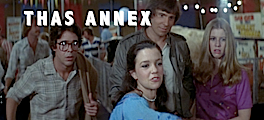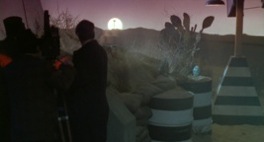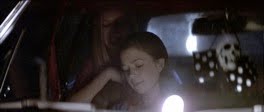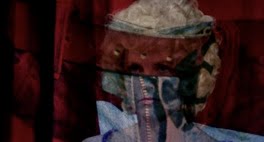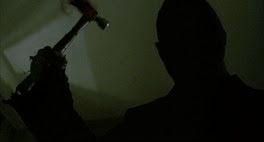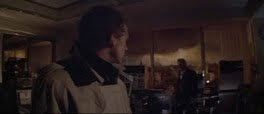d
Hooper may do very much wrong, it's true, but I value him because he does very much
more -- with cinema as an elegant, sculptural form, and as being of meaningful, allegorical structures, all without staking any novel stylistic territories beyond use of a minimal "poetic" camera to a maximal degree of literate, thoughtful cinematographic and dramatic inspiration. In his use of the so-called "simple" (as opposed to the, say, De Palma- or Scorsese-esque), Hooper creates with a relative sense of stylistic "anonymity," but this very point is perhaps the deepest claim to his great humanist character and his sincerest investment in immersing himself in traditions of art, articulacy, theatricality, genre, and transcendence as opposed to fashion (Kiyoshi Kurosawa's foremost compliment to Hooper is
simply for his perceived grasp, permeating into his films, of the history of the horror genre).
The Mangler may be his biggest goof. It is not a tight, controlled tonal or formal machine. It has all kinds of fat, mostly
involving Ted Levine's police officer character.
Texas Chainsaw Massacre,
The Funhouse, even
Night Terrors, bad sex scene and all, are conceptual vehicles of subtle and severe narrative and tonal designs. Meanwhile,
The Mangler is Hooper's most thoroughly commercial endeavor since his slasher sequel (
TCM 2), without even the mostly-prosaic
Invaders from Mars's offbeat, alienating tonal awareness.
The Mangler is entertainment movie-making narrative through and through, with no intended alienation maneuvers - instead just a rip-roaring storyline and a free license to friendly excesses and comedy relief, mainly in the explicit form of a comedic relief character (that would be Ted Levine's annoying, alternative, Berkeley-educated and trivially knowledgeable hippie brother-in-law character, and effective buddy-partner throughout the film). No wonder, not overlooking how cheesy it gets, the film gets no positive marks more complimentary than its being a very, very guilty pleasure.
Yet, damningly, it's a film that represents Hooper so completely and totally as an artistic presence, and, for me, simply one of the most integral pieces in realizing his career as a worthwhile auteur. While I throw clearly superior films like
Texas Chainsaw Massacre 2 and
Invaders from Mars, even
Lifeforce sometimes, under the bus as works I'm not
passionate about, it very often becomes clear to me that
The Mangler is one that I do feel passionate about, simply for the earnest heights it, in moments, presents in Hooper's career. (Add to this proclamation the virtues of
Night Terrors and most of all
Spontaneous Combustion, and there now is the corroboration for my long-ago claim that the 90's is Hooper's true artistic run, where Hooper fully let loose his artistic appetites).
As it so goes,
The Mangler represented a turning point in Hooper's career, and fatefully not a positive one, at least in anyone's eyes but perhaps Hooper's own personal career contentment. Although he'd be in television for the next five years, he would return to theatrical feature filmmaking with
Crocodile,
Toolbox Murders, and
Mortuary, all of which - like
The Mangler - are thoroughly commercial properties, meant to entertain - kills, thrills, and some laughs! - and not weird-out in the ways of any of Hooper's pre-
The Mangler works.
But now with that established, that
The Mangler's great clumsiness is not helped at all by its tonal laxness as a work of impurest horror entertainment, then I am now cleared to put forth the work's great virtue and what makes it soar along and in spite of its daftness - that which automatically makes it worth much more and on a whole other level than
Toolbox Murders (which the technically concerned might be inclined to say is Hooper's most "accomplished" film since the 1980s). I'd like to put my appreciation for
The Mangler quite simply, in contrast to my long-winded build-up: simply,
The Mangler is a film that is so utterly
compassionate, so
completely feeling and humanly-interested of a film. It practically is bleeding at every cut in humane conviction. How many films and their filmmakers, honestly, can say that?
Toolbox Murders simply doesn't compete.
The Mangler's very first shot already gives away its baroque grandeur tied to humanistic expression:
a bullying foreman barks abuses from above as the camera pans down to the working people below.
Whether through Hooper's falteringly disciplined but still unceasingly inspired, florid, and emotive camera, or through his (and his co-writers') oftentimes awful but also still
willfully rich and thematically aspiring screenplay,
The Mangler - in a heart-on-its-sleeve siblinghood with
Spontaneous Combustion - is dripping of elaborate and involved dramaturgy, and a deepness of feeling committed in the marrow of Hooper's directorial realizing of it. Even acknowledging how laughable the screenplay is and even how uncommonly hit-and-miss is Hooper's
mise en scene (of course, even in his misses, he's always striving for something interesting),
The Mangler is a totally invested project, invested with Hooper's innate bleeding heart as much as his innate camera expressiveness, the two confiding, in conjunction with the story's cornball class-conscious drama, to create some of his most feeling and moodily lamenting scene work and character work. These two 90's Hooper films,
Spontaneous Combustion and
The Mangler, join together into a sort of paired glimpse at Hooper working in a mode of unabashed human melodrama and intimate human theater (not that this isn't already seen in the likes of
Eaten Alive and
The Funhouse).
Spontaneous Combustion is the superior film, the wholly "serious work," but
The Mangler pulls
for an astoundingly full-bodied humanist vision in its class,
corruption, and labor parable, even in all its ultimate inanity. Its
thematic layers and net of characters sprawl across a handful of
plotlines and elements of milieu, which is unlike the precise hero's
narrative of
Spontaneous Combustion (modeled after Greek tragedy, similar to the way the procedures of
Lifeforce are sculpted on a "life-cycle adventure" yarn,
Invaders from Mars a building dream,
Texas Chain Saw Massacre and
Eaten Alive, at their most basic level, base slasher formula), and is so more in line with the proliferating,
interweaving, subtext-enriching and metaphor-delineating "plots and
subplots" structure of
The Funhouse,
Salem's Lot,
Night Terrors, and
The Dark.
All these latter films share stories that do not map out a single,
connected series of cause-and-events, but pursue a multiplicity of
extra-narrative or multiple-narrative story elements that make the
progression of the story dependent on its unique dramatic make-up rather
than the formulas that come with alien-invasion or slasher-killer
narratives.
A tangled web of characters and plotlines, woven undercurrents of
personal motivations and fleeting interactions, a subtly connected
milieu of places and environments, are what make
The Funhouse,
Salem's Lot,
Night Terrors, and
The Dark as thematically, richly abstracted as they are.
The Mangler
is not as esoteric or intricate as any of those films, but the humanistic
narrative scope is indeed in play here, making the film a tangle of competing threads between the film's vying heroes, villains, and
victims: Ted Levine's embittered and bereaved cop protagonist counting the days towards his pension (which we will eventually see him lose during the course of the film, due to his challenging the powers-that-be); the
pitiable and perpetually victimized Sherry (symbol of innocence and
sacrificial lamb, kept cloistered and fragile in order to harvest her
virgin's blood); and the villainous factory owner and exploiter
Gartley, who the film follows almost in a mode of moral-character exegesis,
allowing him
numerous intermittent, isolated moments where he explains more and more his psychology, worldview, and motivations,
before the film pulls
a wonderful curve ball in humanizing the villain (indeed a trope of
Hooper's) when he is emotionally revitalized by his coerced love
affair with a pretty young worker Lin Sue, who then has her
own story arc - a working woman who is lifted up (by her rapist Gartley) into the privileged realm of wealth and abuse. Add on to this cast of characters the foreman George, being
paid his living for being a dumb slave driver, and only proving himself dumb (in this world of power and corruption) when he finally takes a moral stance on behalf of himself.




















Even if it's never fully realized, it's painfully clear Hooper is always
so invested in human drama.
The Mangler to
Night Terrors to
The Funhouse, to
Eaten Alive and
The Dark: all richly subtextual works that weave together plots and subplots, tonal consistencies and
inconsistencies, main characters and bit characters, into a subtle collage of dramas and emotional themes.
** ending spoilers following **
The Mangler is a late work literally awash in Hooper's "goodery," his kindliness and compassion,
not to mention his dumb love for fantastical humanist metaphor. Like
The Funhouse's funhouse, the "Mangler" machine is one big metaphor. The ridiculous premise of an
industrial city stuck in time, with a laundry factory straight out of an
Upton Sinclair novel or Charles Dickens scenario, revealing an anachronistic world of timeless civic
corruption and blue-collar purgatory... it's dumb, and Hooper obviously
does not pull it off with any sense of sensible reality, but
at
the same time, it's somehow also terribly smart by virtue of the screenplay's earnestly arched-for scope and insight, and Hooper's aspirant visual work. Give it the benefit of its clear, ambitious vision: the blunt scale and design of
the titular machine, its metaphorical monster, a stunning mechanical monstrosity and perfectly evocative as a representation of the corrupted, steaming beast that is American industry, its massive gears and cogs a clear evolution from the wooden ones that kill the poor mutant in
The Funhouse; the weird timelessness of the film, to evoke the "stuckness" of this city, the old crooked system that simply cycles anew, where a cancerous J.J.
"Pictureman" still takes police photos with a flash bulb and a tycoon can still own a judge who can own the sheriff; the
fantastical cross-narratives of transferred evil, from an extraneous plot sideline concerning the suffocation of an innocent little boy by Mangler-contaminated icebox (a scene of the most earnest self-lampoon job since the entirety of
Exorcist II)
, to the
film's end, where the silliest-seeming final twist - the character of Sherry's "transformation" into her uncle - is actually the most yearning, mournful, selflessly ill-advised, ill-advisedly selfless decision by the movie, a laughable twist not pretending to be shocking or sinister or not-laughable, but made to be horribly mundane and simply unfortunate on a very small, human level (and thus all the more tragic), abetted in a resolutely benign way by the simple sight of Ted Levine giving his best puppy-dog look of crumbled romance in deep foreground, to the film's choice of score, a cheesy-sweet
piano track, not sinister strings or rumbling basses.
It's
terribly smart not because it's smart, but because it's so terribly
compassionate and world wary - if in a dumb way, at least in a
perceiving way. There is something truly affecting about Sherry's permanent fate, and it's completely one with its silliness, surely coming off more feeling and compassionate, sincere and humanely self-obligated, than if it were somehow managed to be played utterly seriously. I
may laugh at its execution, but if it's half badly executed, it's half
brilliantly executed because I do feel the deep regret (of a life "lost," not in horror movie death but in metaphoric death of the soul) that Hooper wants me
to feel. If this shot is terribly cheesy, it's
half terribly brilliant, in that I know
exactly what he's going
for in his deep-peering shot of Levine's slowly perceiving face, and I marvel at the way, in one fell swoop of a single panning and dollying shot, he has us see two renewals (or more, such as the mangler itself, or if you notice the Annette look-alike at the mouth of the mangler, Annette being the girl
burnt by steam hoses early in the film), Sherry and the foreman, joining in the frame at the shot's terminus in a malignant harmony of movement and placement, Sherry as the
Gartley-renewel and the new foreman posed behind her, a rather haunting look-alike (at least in build and body type) of the
first foreman we see die earlier - a look-alike, or clear stand-in, but now
younger, sharper, sharper-
looking, and inexorably more uncaring and dispassionate, another willing, complicit,
evolved cog in the callous
system.
/End of Part I/




























































